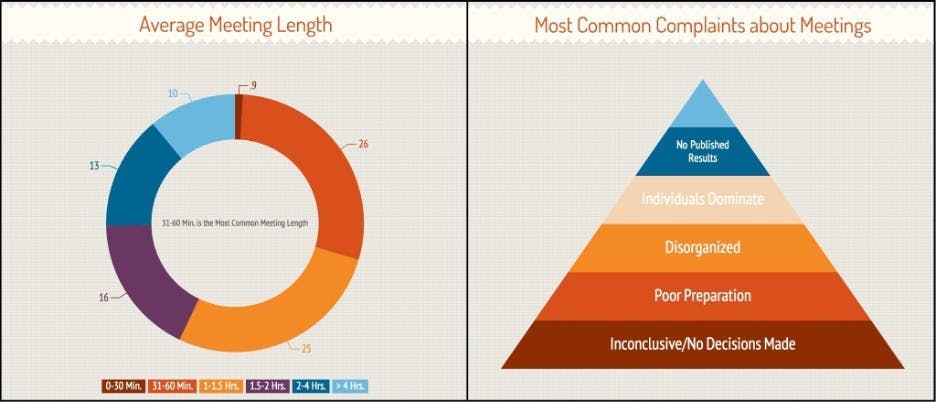The Ups and Downs of No Meeting Days

The obligatory Monday morning meeting should be energizing and inspiring, yet they can easily get derailed, leaving questions in the air and doubt in your team.
It’s not just the first gathering of the week that’s disaster prone – in the wrong hands, any meeting is moments away from chaos. When clear structure and effective communication are nowhere to be seen, they do more harm than good.
The effectiveness of meetings has long been pondered. There have been many inventive solutions for jazzing up a meeting but knowing when to avoid them is just as crucial for a productive working week.
How Long Do Most People Spend in Meetings?
A 2019 survey, quizzing just shy of 2,000 workers, found that 67% of respondents agreed spending too much time in meetings significantly distracts them from their work, with only 11% claiming that all meetings were productive.
At the same time, 65% said they’d decline an invitation if they perceived the meeting to be a poor use of their time. In reality, the freedom to pick and choose meetings isn’t something that we all share, and even those who can risk seeming indifferent and uncooperative.

(Source:attentiv)
While meetings running too long and/or lacking direction are common complaints, there’s also something to be said about the number of meetings one has per week.
2014 Ovum research argues we have an average of 8 meetings a week, quickly rising to 12 for higher-management roles, and 17 for directors or top executives. In fact, the frequency of meetings increases as you climb the corporate ladder, resulting in senior leaders spending around 50% of their time in meetings.
Considering that most meetings fall somewhere in the 31-60 minute range, as told in an Attentiv study, it’s not implausible that the average worker spends 8 hours a week in meetings.
It’s obviously worthwhile to explore the ways in which meetings can be streamlined. There is plenty of research on effective team meetings, including having a solid agenda, relevant focus, and a clear leader.
Likewise, there’s lots of stuff on how to have fewer meetings, through ensuring strict scheduling, optional invites, and a feedback process.
Of course, there is an even simpler solution that we’re missing… none at all.
Why Have a No Meeting Day?
Getting hands on a no-meeting day surely feels like an impossible task for remote workers. Often taken for granted, they can have long hours of hard work, only to be rewarded with an incessant stream (or overwhelming tsunami) of meetings that encroach on their productivity. It’s under the facade of optimum communication, but it can be too much of a good thing.
In fact, the Wundamail Work from Home 2020 Report, shows more than half of the 20,000 respondents wished to limit virtual meeting time, preferring to have long stretches of uninterrupted time in order to better achieve their tasks. Meanwhile, 42% of participants stressed they frequently connect to video conferences yet contribute nothing.
When there’s plenty of work to be done, and little time in which to do it, no organization should be calling for countless catch ups. Effective correspondence can be achieved through written mediums, such as email or a centralized work hub, while progress checking could take the form of a brief daily task report.
A large bulk of meetings find themselves outside of the critical path towards accomplishing a goal. Regularly scheduling meetings in the midst of a busy period stalls a group, with the stop-start rhythm making it vastly more difficult for each member to maintain the focus needed for top-quality work.
Organizations that embrace remote work policies, and by extension value their remote workers, should seriously consider the value of offering a day without meetings. For office-based companies, it's doubly important to eliminate unnecessary face-to-face meetings, as even more time is wasted physically traveling back and forth.
It’s suspiciously simple: if you’d like for an employee to complete assignments and stay productive, leave them alone for a while.
What Are the Benefits of No Meeting Days?
Seeing as a considerable chunk of people take great issue with meetings, the most immediate benefit of no-meeting days is, well, no insufferable meetings. Joking aside, the advantages of a meeting-free day are numerable:
1. More Time for Actual Work
A truly beautiful Atlassian infographic shows that 73% of meeting attendees actually spend the time doing other work, implying that what they really want is to just get back to their desk. Once you look at it that way, it’s bizarre to think employees are repeatedly dragged to these faux-gregarious gatherings, especially as the alternative - allowing them to get on with stuff – is far easier.
Once you’re aware that a meeting is coming up shortly, you may mentally clock-out from the task at hand. After idly daydreaming in irrelevant meetings, you’ll need to accelerate back up to speed, reaffirming the current goal and reestablishing concentration. Research shows that it can take as much as 23 minutes to return to work after a distraction.
A no-meeting day eliminates this interrupted rhythm, giving people the opportunity to fully commit to their responsibilities and keep their rate of work level.
"Our ‘No Meetings Friday’ rule is designed to give people more control of their calendars. So, instead of banning meetings altogether (which in my experience doesn’t really work at larger companies), we don’t have any recurring meetings on that day and encourage everyone to only meet if all parties feel it’s a good use of time and necessary," says John Yarbrough, head of content and communication at AlertMedia.
2. Enhanced Focus
It’s not just that workers end up committing more time to the work, but also that they reach the deeper focus necessary for the most difficult tasks.
We’ve spoken about the importance of single-tasking, that deep focus on a single objective is, in many cases, the most productive method of tasking. ‘Getting in the zone,’ known psychologically as the flow state, is a hugely powerful tool for maximizing work output.
Regardless of whether they’re productive or not, meetings kill this flow. It's a tradeoff between focus and communication, whereby you sacrifice the former for the latter. It’s entirely necessary for coordinating a team, but there’s a cutoff for how much focus you trade away.
No-meeting days promote the flow state, allowing workers to schedule their most challenging tasks for a time that’s unburdened by interruptions.
3. Boosted Morale
Pointless meetings communicate to a worker that their time is worth wasting. On the other hand, mandating a no-meeting day expresses that their work process is respected. Such a message can positively influence morale, as well as strengthen relationships between team members, by illustrating that a person is trusted to spend their time wisely.
In other words, it contributes towards an employee feeling valued. One popular 2012 study, from the American Psychological Association, found that 93% of those who felt valued were motivated to do their best at work. Conversely, a mere 33% of those who considered themselves unvalued felt that same energy.
When information does not warrant a meeting, but rather an email or a one-on-one chat, yet goes ahead anyway, morale suffers. In effect, a no-meeting day forces everyone to experiment with other means of communication, promptly discovering that they can definitely get by without a hundred huddles a day.
Do No Meeting Days Increase Productivity?
For such a significant question, it's important to look at the big picture. If your group, department, or company spends a lot of time having meetings, there is a good chance that your productivity is suffering.
However, if meetings are executed well, they won’t be doing much harm to productivity.
Parkinson's Law dictates that “work expands so as to fill the time available for its completion,” a cynical jab at bureaucratic work practices. When applied to meetings, Cyril Northcote Parkinson’s theory explains how even meetings that lack content – and really can’t be justified – still seem to run out the clock, every time.
Accordingly, the earlier mentioned Wundamail survey found that 73% of respondents regarded video-conferencing as getting “work done”, suggesting that meetings can give a false sense of heightened productivity and time well spent.
It’s easy to slip into these dangerous meeting habits, forgetting what matters most: completing tasks. Parkinson’s Law is indicative of the importance of proper scheduling, though it can also act as a supporting argument for no-meeting days.
No-meeting days will absolutely increase productivity if many of a team’s meetings aren’t critical to the decision-making process of a project or aim. In most cases, that’s true, so a large proportion of companies will undoubtedly see drastic improvements to productivity by enforcing a no-meeting day.
Tips for Implementing a No Meeting Day
Finding new ways of boosting performance is admirable, whether it’s a pursuit done individually or as an organization. In fact, it’s one of the most integral team lead responsibilities. If you’re interested in implementing a no-meeting day, there’s no wizardry to it… just go for it!
You may need to experiment with the precise day of the week, but we’ve got some tips for making sure you have great success with it:
1. Don't do it alone
If you’re the head of a department, or one of several organizational leaders, it’s far more powerful to have an unanimous decision on your no-meeting day. It’s great for one manager to have the freedom to choose not to hold meetings, but the benefits are far more observable when the method is adopted across an entire company.
By taking the time to set up organizational standards, you establish the ethos that work is defined by results, not endless meetings.
2. Be flexible
The ultimate goal is to keep the office calm and minimize interruptions, which does require some flexibility. As the hectic work week elapses, you may suddenly find it’s integral to convene a meeting. If this need arises, you don’t necessarily need to postpone valuable information in efforts to preserve a no-meeting day.
Colleagues may react negatively but try to make them understand that you're trying to give them every opportunity possible to focus on getting their work done, yet some flexibility on both parts is most advantageous.
3. Combine your No Meeting Day with a Calendar Audit
Taking the time to audit calendars, seeing exactly where time is going, is immensely valuable insight into both a team’s time-management abilities and larger organizational wastefulness. You'll get better results if you audit your team's calendars at the same time you introduce the no-meeting day policy.
While being attentive to employee calendars enables you to monitor the relationship between meetings and results, it also acts as reinforcement for the necessity of the no-meeting day itself. You'll find that some employees are in far too many meetings, while others are not in any meetings at all.
Unless you keep an eye on these changing trends, you won’t be able to determine whether your no-meeting day is effective.
4. Make No-meeting Days Easier with Automated Technology
Aside from face-to-face meetings, there are multiple ways to communicate internally within a company. There has been a huge rise in virtual meetings, used to alleviate meeting fatigue from psychical meetups, though too much of any meeting still causes negative consequences.
If you use software to consolidate work communications, no-meeting days can be more easily implemented, managed, and adapted.
5. Don't Expect No-meeting Days to Fix Everything
Not all work problems are related to meetings, so it follows that implementing a no-meeting day doesn’t solve all issues. If someone’s performance is judged by how many meetings they were in, the entire system is flawed. Larger changes must be made before the benefits of no-meeting days can be seen.
It makes no difference whether an employee has attended 100 meetings or zero, especially when you learn that 91% of us regularly daydream during them. What actually matters is getting results. For teams that are already performing well, no-meeting days can be considered a kind of reward; for poorly optimized workplaces, no-meeting days could exacerbate existing communication shortfalls or time-management inefficiencies.
The Limitations of No Meeting Days
The worry that no-meeting days could quickly become no-meeting weeks is laughable. Meetings are an irreplaceable component of work, vital for communication, collaboration, and progress.
If you're a manager with a staff that includes remote workers, or you’re looking at integrating them into your team, a no-meeting day policy can help massively, reducing information overload and meeting fatigue.
However, communication is the key element for remote working, if not all work. It's the only way that people from different locations share what they’re currently preoccupied with and any later developments. Additionally, meetings are the ideal place for throwing out ideas real-time, asking questions that improve outcome.
Encouraging team members to throw out ideas at their desks, as they would during meetings but now on their own time, might not be the optimal solution either, as they’ll have limited access to the information needed to make well-informed decisions.
In certain scenarios, no-meeting days will prove impractical, which is neither a good nor bad thing. Depending on how a team relies on meetings, eliminating them (even for a day) could result in less overall work getting done.
Managers need to recognize that not every activity that takes place in the office requires a meeting, and that best outcomes often result from workers collaborating offsite. While it’s tempting to use meetings as a way to constantly monitor remote workers, or check up on the office, that’s not what they’re designed to achieve.
Meetings have their place, for both remote teams and office workforces, though they sometimes get in the way of quality work. Setting aside a day of the week unhindered by meetings may sound like less communication, but when most of the room is daydreaming, snoozing, or quietly working on other things, how much is really being heard?
Frequently Asked Questions on Meetings
See how no-meetings days can benefit your team.


